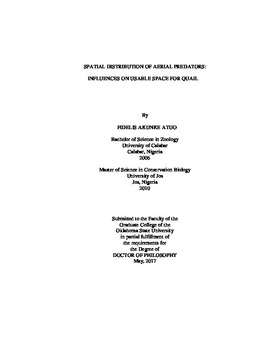| dc.contributor.advisor | O'Connell, Timothy J. | |
| dc.contributor.author | Atuo, Fidelis Akunke | |
| dc.date.accessioned | 2018-04-23T19:35:57Z | |
| dc.date.available | 2018-04-23T19:35:57Z | |
| dc.date.issued | 2017-05 | |
| dc.identifier.uri | https://hdl.handle.net/11244/299537 | |
| dc.description.abstract | The likelihood of encountering a predator influences prey behavior and spatial distribution such that non-consumptive effects can outweigh the influence of direct predation. Prey species are thought to filter information on perceived predator encounter rates in physical landscapes into a landscape of fear defined by spatially explicit heterogeneity in predation risk. The presence of multiple predators using different hunting strategies further complicates navigation through a landscape of fear and potentially exposes prey to greater risk of predation. The juxtaposition of land cover types likely influences overlap in occurrence of different predators, suggesting that attributes of a landscape of fear result from complexity in the physical landscape. Woody encroachment in grasslands furnishes an example of increasing complexity with the potential to influence predator distributions. I examined the role of vegetation structure on the distribution of avian predators, and the vulnerability of a frequent prey species of those predators, Northern Bobwhite (Colinus virginianus). I mapped occurrences of raptors and kill locations of Northern Bobwhite to examine spatial vulnerability in relation to landscape complexity. Predator density and predation-specific mortality of Northern Bobwhite increased with vegetation complexity generated by fine-scale interspersion of grassland and woodland. Predation pressure was lower in more homogeneous landscapes where overlap of the two predators was less frequent. Predator overlap created areas of high risk for Northern Bobwhite amounting to 32% of the land area where landscape complexity was high and 7% where complexity was lower. My study emphasizes the need to evaluate the role of landscape structure on predation dynamics and reveals another threat from tree encroachment in grasslands. | |
| dc.format | application/pdf | |
| dc.language | en_US | |
| dc.rights | Copyright is held by the author who has granted the Oklahoma State University Library the non-exclusive right to share this material in its institutional repository. Contact Digital Library Services at lib-dls@okstate.edu or 405-744-9161 for the permission policy on the use, reproduction or distribution of this material. | |
| dc.title | Spatial distribution of aerial predators: Influences on usable space for quail | |
| dc.contributor.committeeMember | Davis, Craig A. | |
| dc.contributor.committeeMember | Leslie, David M., Jr. | |
| dc.contributor.committeeMember | Elmore, Dwayne | |
| dc.contributor.committeeMember | Papes, Monica | |
| osu.filename | Atuo_okstate_0664D_15235.pdf | |
| osu.accesstype | Open Access | |
| dc.type.genre | Dissertation | |
| dc.type.material | Text | |
| thesis.degree.discipline | Natural Resource Ecology and Management | |
| thesis.degree.grantor | Oklahoma State University | |
